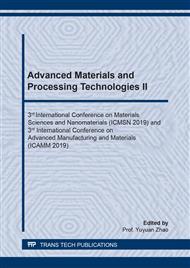[1]
Vedran Ivanac, Bojana Dalbelo Basic, and Zvonimir Vanjak: Construction and Evaluation of Cellular Automata Lattice Based on the Semantics of an Urban Traffic Network, Journal of Cellular Automata, vol. 8, no. 5/6(2013), pp.417-428.
DOI: 10.1007/978-3-642-33350-7_83
Google Scholar
[2]
Juraj Cirbus, Michal Podhoranyi: Cellular Automata for the Flow Simulations on the Earth Surface, Optimization Computation Process, Applied Mathematics & Information Sciences, vol. 7, no. 6(2013), pp.2149-2158.
DOI: 10.12785/amis/070605
Google Scholar
[3]
Lorenza Manenti, Sara Manzoni, and Stefania Bandini: A Stochastic Cellular Automata for Modeling Pedestrian Groups Distribution, Journal of Cellular Automata, vol. 8, no. 5/6(2013), pp.321-332.
DOI: 10.1007/978-3-642-33350-7_31
Google Scholar
[4]
E. Martinelli, E. A. B. Koenders, and A. Caggiano: A numerical recipe for modelling hydration and heat flow in hardening concrete, Cement and Concrete Composites, vol. 40(2013), pp.48-58.
DOI: 10.1016/j.cemconcomp.2013.04.004
Google Scholar
[5]
M. Briffaut, F. Benboudjema, J. M. Torrenti, et al: Numerical analysis of the thermal active restrained shrinkage ring test to study the early age behavior of massive concrete structures, Engineering Structures, vol. 33, no. 4(2011), pp.1390-1401.
DOI: 10.1016/j.engstruct.2010.12.044
Google Scholar
[6]
J. H. Hattel, J. Thorborg: A numerical model for predicting the thermomechanical conditions during hydration of early-age concrete. Applied Mathematical Modelling, vol. 27, no. 1(2003), pp.1-26.
DOI: 10.1016/s0307-904x(02)00082-3
Google Scholar
[7]
Z. M. Zhang, Y. Zhang, and Z. T. Song: Analysis of hydration heat induced temperature rise in massive concrete walls, Journal of Hohai University (Natural Sciences), vol. 30, no. 4(2002), pp.22-27.
Google Scholar
[8]
M. N. Amin, J. S. Kim, Y. Lee, et al: Simulation of the thermal stress in mass concrete using a thermal stress measuring device, Cement and Concrete Research, vol. 39, no. 3(2009), pp.154-164.
DOI: 10.1016/j.cemconres.2008.12.008
Google Scholar
[9]
I. Chu, Y. Lee, M. N. Amin, et al: Application of a thermal stress device for the prediction of stresses due to hydration heat in mass concrete structure, Construction and Building Materials, vol. 45(2013), pp.192-198.
DOI: 10.1016/j.conbuildmat.2013.03.056
Google Scholar
[10]
Y. Y. Lu, J. R. Zhang, and Z. J. Li: Study on hydration process of early-age concrete using embedded active acoustic and non-contact complex resistivity methods, Construction and Building Materials, vol. 46(2013), pp.183-192.
DOI: 10.1016/j.conbuildmat.2013.04.032
Google Scholar
[11]
J. Zhang, L. Qin, and Z. J. Li: Hydration monitoring of cement-based materials with resistivity and ultrasonic methods, Materials and Structures, vol. 42, no. 1(2009), pp.15-24.
DOI: 10.1617/s11527-008-9363-0
Google Scholar
[12]
F. Biondini, F. Bontempi, D. M. Frangopol, et al: Cellular automata approach to durability analysis of concrete structures in aggressive environments. Journal of Structural Engineering, vol. 130, no. 11(2004), pp.1724-1737.
DOI: 10.1061/(asce)0733-9445(2004)130:11(1724)
Google Scholar
[13]
C. I. Christov: On a Higher-gradient Generalization of Fourier's Law of Heat Conduction, AIP Conference Proceedings, vol. 946(2007), pp.11-22. United States, IOP Institute of Physics Publishing Ltd.
Google Scholar
[14]
H. Asan: Numerical computation of time lags and decrement factors for different building materials, Building and Environment, vol. 41, no. 5(2006), pp.615-620.
DOI: 10.1016/j.buildenv.2005.02.020
Google Scholar
[15]
C. Cuadrado-Laborde, L.C Damonte, and L. Mendoza-Zélis: Theoretical treatment of a self-sustained, ball milling induced, mechanochemical reaction in the Fe2O3-Al system, Materials Science and Engineering A, vol. 355, no. 1-2(2003), pp.106-113.
DOI: 10.1016/s0921-5093(03)00075-3
Google Scholar
[16]
G. De Schutter: Finite element simulation of thermal cracking in massive hardening concrete elements using degree of hydration based material laws, Computers & Structures, vol. 80, no. 27-30(2002), pp.2035-2042.
DOI: 10.1016/s0045-7949(02)00270-5
Google Scholar
[17]
Z. M. Zhang, S. R. Feng, Q. C. Shi, et al: Adiabatic temperature rise of concrete based on equivalent time, Journal of Hohai University (Natural Sciences), vol. 32, no. 5(2004), pp.573-577.
Google Scholar
[18]
A. Abbasi, P. J. Hogg: A model for predicting the properties of the constituents of a glass fibre rebar reinforced concrete beam at elevated temperatures simulating a fire test, Composites Part B: Engineering, vol. 36, no. 5(2005), pp.384-393.
DOI: 10.1016/j.compositesb.2005.01.005
Google Scholar
[19]
D. P. Bentz, V. Waller, and F. de Larrard: Prediction of Adiabatic Temperature Rise in Conventional and High-Performance Concretes Using a 3-D Microstructural Model, Cement and Concrete Research, vol. 28, no. 2(1998), pp.285-297.
DOI: 10.1016/s0008-8846(97)00264-0
Google Scholar


